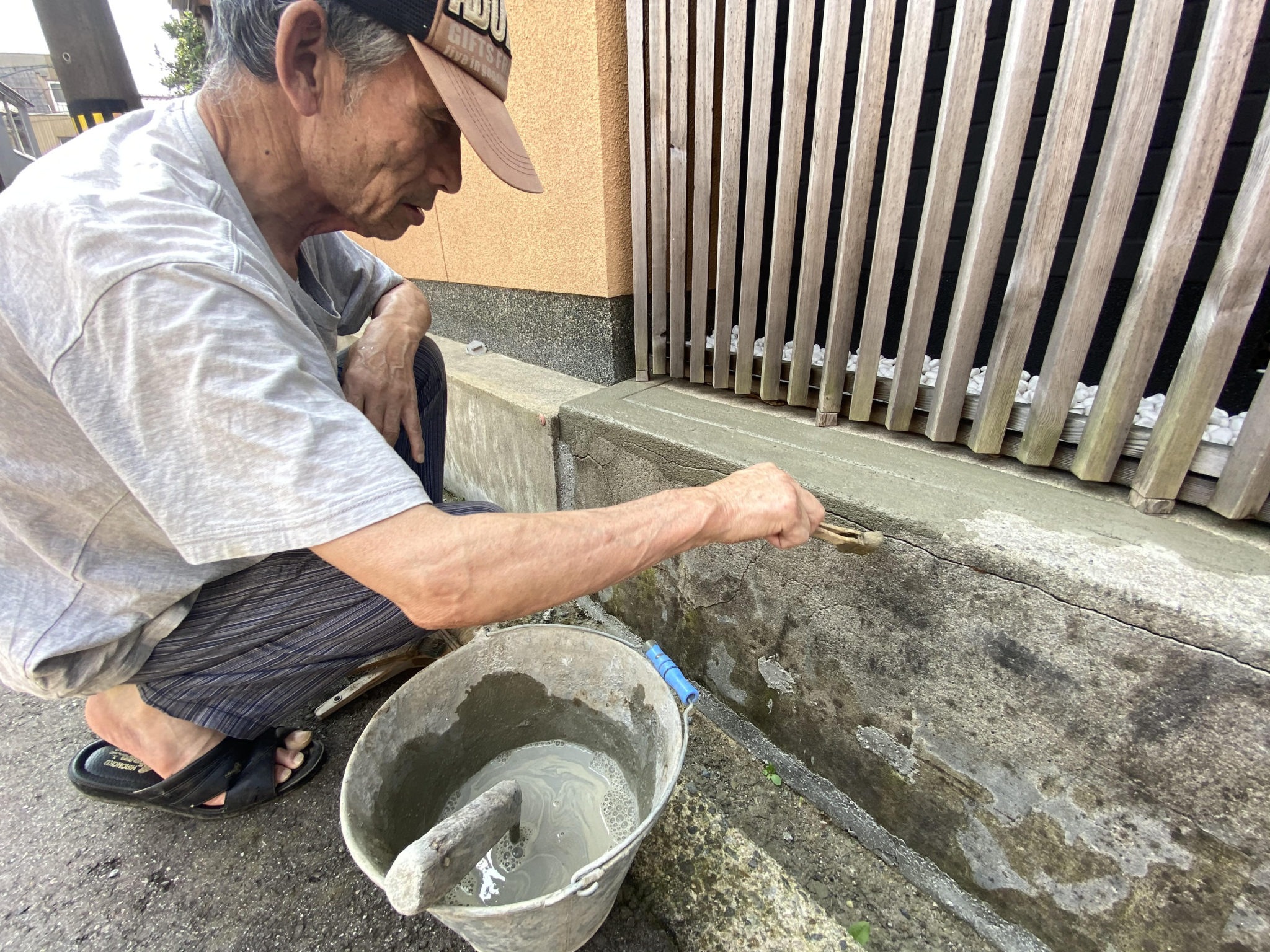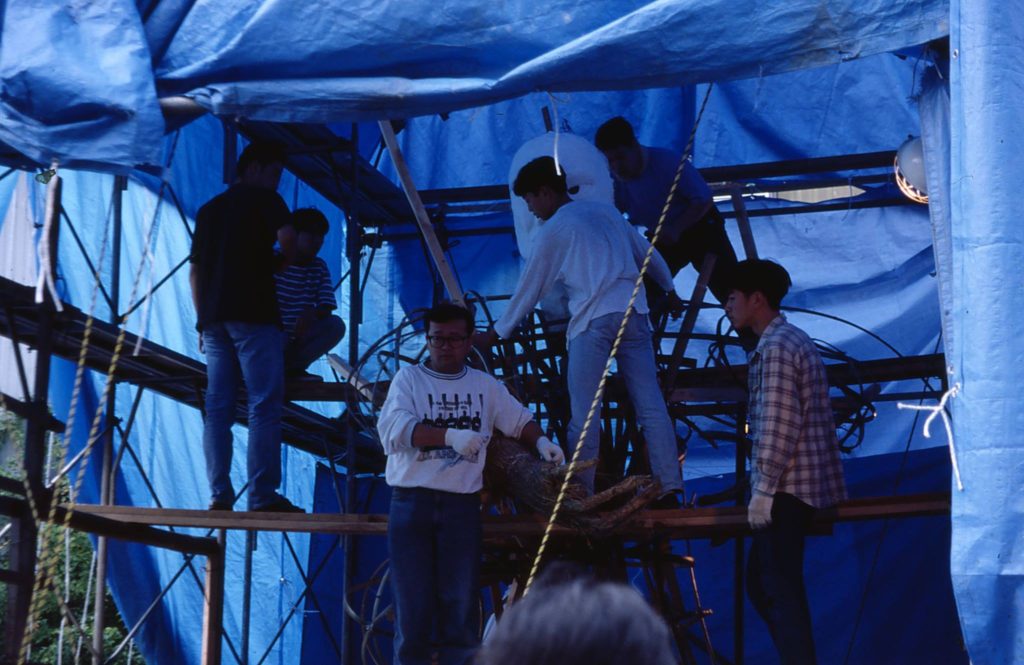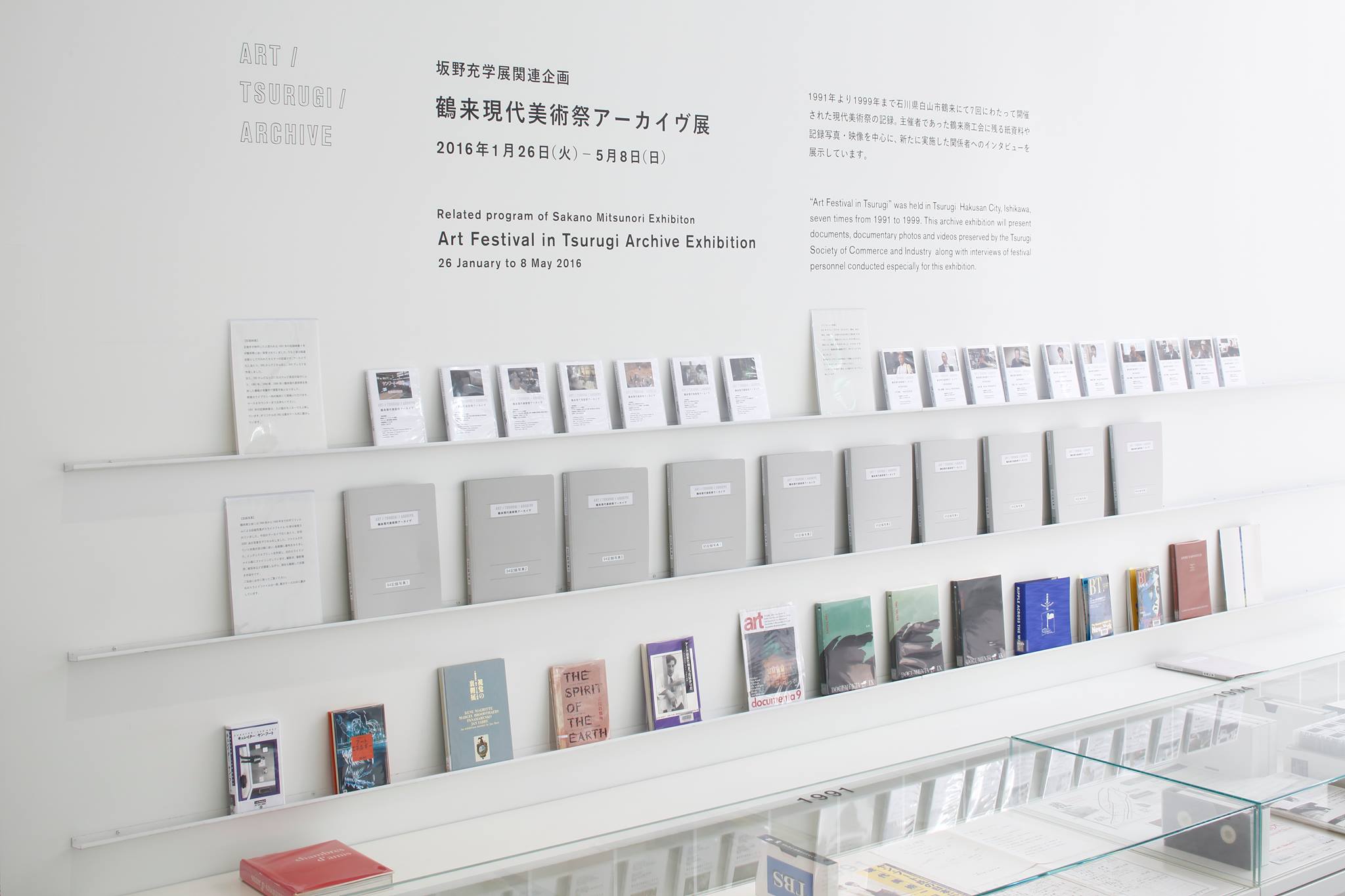古都金沢だからこそ生まれた、
ARTS & STAYというプロジェクト。
A project born only in Kanazawa

近隣住民による金箔製造の作業風景
多くの職人たちが暮らし、職人町として栄えた古都金沢ひがし茶屋街の近くにある「森山」。かつては染色、加賀友禅、大工、表具、畳、木箱づくり、建具、左官、金箔といった、まちに根付いた伝統産業でありつつも規模的には小さな「諸職」と呼ばれる専門職の人々が、住居兼工房として暮らしてきました。工房がつらなり風情あるこの光景も、ここで暮らす人にとっては日常であり生活圏です。しかし時代の変化の波とともに、金箔打の騒音問題で、昭和に職人たちが金沢北部へと去り、業種自体が姿を消えたこともあり、いつしか職人たちはこのまちから消えていきました。
The Moriyama area of Kanazawa, where many craftsmen lived and prospered as a craftsman’s town. Once a traditional industry rooted in the town, such as dyeing, Kaga Yuzenn, carpenters, tableware, tatami mats, wooden box making, fittings, plastering, and gold leaf, I have lived as a residence and a workshop. This spectacle of the workshops is a daily life and a living area for the people who live here. However, with the wave of changes in the times, due to the noise problem of gold leaf, the craftsmen left the northern part of Kanazawa in the Showa era, and the industry itself disappeared, so the craftsmen disappeared from this town.

かつて職人が多く住み「大衆免」(だいじゅめ)と呼ばれた特区が、ARTS&STAYの舞台
さらには人口減少・住民の高齢化もあり、空き家が増えたのがいまのARTS&STAYの舞台となる森山の小さな路地です。ほかの地域同様に、時代とともに役目を終えた建物は今もそこに在り、次の時代に向けての新陳代謝を待ち望んでいるのに、現実にはなにも起こらない日々が続いてきました。
Furthermore, due to the declining population and the aging of the inhabitants, the number of vacant houses has increased in the current Moriyama area. As in other regions, buildings that have finished their role with the times are still there, and although they are waiting for metabolism for the next era, the days when nothing actually happens have continued.

ARTS & STAYはそんな森山の小さな路地に、ささやかな風を起こそうと思っています。暮らす人たちに漣を起こすような風ではなく、そよそよと気持ちのいい風が通り抜ける路地の風景をつくる。それがARTS & STAYの取り組むプロジェクトです。
ARTS & STAY wants to create a small breeze in such a small alley in the Moriyama area. It creates a landscape of alleys through which a pleasant breeze passes, rather than a wind that causes a sensation to the people who live there. That is the project that ARTS & STAY is working on.

ARTS&STAYでは日々継続的に、地元の職人の協力で建物を修繕している
ARTS & STAY の軌跡
Trajectory
金沢の中心市街地から車で30分ほどの山間部にある鶴来(白山市)に生まれ育った私は、物心のついたころから古い町家が連なる風景の中で生活していました。まちの一大イベントである秋のほうらい祭りが近づけば、近所の面々が集まり祭支度をするのが原風景です。1992年、鶴来の町家・蔵を展示会場とした「鶴来現代美術祭」が実家の周りで突如と開催されました。初めて目にするものたちが、昔から変わらないと思っていた小さなまちの景色を変えたのです。それが私と現代アートとの出会いです。
Born and raised in Tsurugi (Hakusan City), located in the mountains 30 minutes from the center of Kanazawa, I have lived in a landscape of old townhouses for as long as I can remember. I particularly recall the autumn as I grew up. As the autumn festival approached, the neighbors came together to prepare for the festivities. I remember always looking for the more subtle things during my childhood, always looking for something interesting in my daily life, which has always been within the Tsurugi landscape and customs.

秋祭りのために「造りもの」と呼ばれる造形物の制作プロセスを眺めるヤン・フートと参加作家(1991)
Photo collection: Mitsunori Sakano

「造りもの」の骨格を、地元で竹と木材で組む地元の新町青年団のメンバー(1991) Photo collection: Mitsunori Sakano

「造りもの」の制作方法を取り入れた新作を鶴来で滞在制作するフランツ・ウエスト。完成作品は翌年「水の波紋」展(ワタリウム・東京)で発表された。(1994) photo collection: Mitsunori Sakano

伝統的な町家や蔵を舞台にした鶴来現代美術祭(ヤン・フートin鶴来91’)の展示会場風景(1994年)
Photo collection: Mitsunori Sakano
その衝撃は若い私に大きな影響を与え、10代の終わりにミュンスター彫刻プロジェクトをみるためにドイツに足を運ぶなど、ストリートとアートが一体となるうねりを見て回ることとなりました。 そうしていくうちに、人の住む生活空間を舞台にした世界初の芸術祭とされる「シャンブル・ダミ展(1986年、ゲント市、ベルギー)」のキュレーターが、私のアート初体験である「鶴来現代美術祭」の仕掛け人、ヤン・フートであることを知り、25年の時に埋もれたこの小さな事件を1人記録しはじめました。破棄されかけた資料や作品を収集・保存し、後に「鶴来現代美術祭アーカイブ」と名付けた展覧会として各地で巡回し、収集記録を紹介してきました。
In 1991 the Tsurugi Contemporary Art Festival used the traditional houses and storage spaces around my family home as exhibition spaces. An encounter with contemporary art in a small town such as Tsurugi changed the traditional landscape for me in an influential way. After that, at the end of my teens, I went to Germany to see the Münster Sculpture Festival and saw a similar dynamism with its mixture of urban spaces and art. At the same time, I came across the Chambre Dami Exhibition (1989, Ghent, Belgium), which is said to be the world’s first art festival set in a living space curated by Jan Hoet, curator of the Tsurugi Contemporary Art Festival.

“chambres d’amis” Archive book(1989′) Book Collection: Mitsunori Sakano

「Tsurugi Contemporary Art Festival Archive」(Kanazawa contemporary art museum, 2016), Courtesy of Kanazawa contemporary art museum

Exhibition “Tsurugi Contemporary Art Festival Archive” (Nagoya MAT, 2017), Courtesy of Nagoya Minatomachi Art Table
人がつながり、ひとつのことを目指し、次の世代に継承していく「土着の祭」と「アートフェスティバル」、「日本ならではの町家や路地裏」と「美術館やギャラリー」。世界をまわり、似ているようで相反する二つのコトやバを行き来しながら「フェスティバル」でも「展示空間」でもない住空間、あるいは生活の延長線上にあるコトのような、バのような何かをつくろうと考えました。住空間にアートがあり、プライベートな空間と時間がある状況。その発想から、宿の機能をもった路地裏空間をつくることになりました。現在進行形でつくり続けているARTS & STAYですが、日常の延長線上にアーティストと旅人が行き来し、流れのままに形を変えていきます。着地点をつくらないプロジェクトは、発見をもたらす場としてこれからも変化し続けるでしょう。
− ARTS & STAY 代表 坂野充学
In the same way the Art Festival Archive keeps these traditions alive. The use of traditional Japanese houses and the urban spaces for exhibiting art has always been fascinating to me, rather than the use of museums and galleries. This is why I have created ARTS & STAY to continue this way of experiencing art. As time went I went around the world and traveling back and forth whilst always returning to Tsurugi. As an artist I thought about creating a living space that is neither a “festival” nor an “exhibition space” but something that is an extension of life itself.
By combining art and the living space, my intention was to create a space with the function of an “accommodation facility” in order to create a situation where there is plenty of time to experience this private yet curated space. ARTS & STAY as a project is intended to have its own life. In everyday life, artists and travelers will come and go, and the direction of the project will change naturally.
-Mitsunori Sakano
Profile
